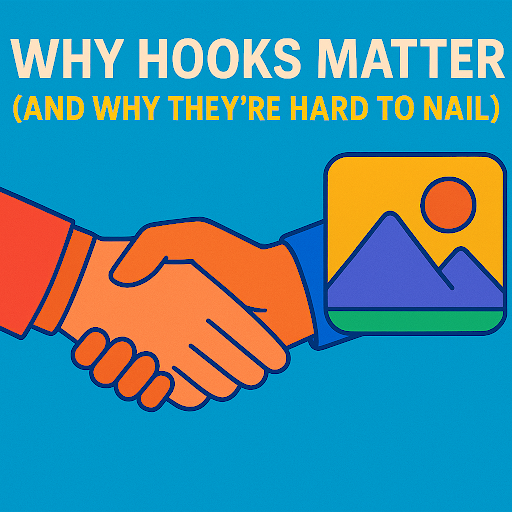If you’re struggling to create engaging ads that grab attention right away, you’re not alone. Writing a compelling hook—the critical first few seconds or words that pull your audience in—can be tricky even for seasoned marketers. Now that AI ad generators have become popular, many hope these tools can solve the problem instantly. But like all tools, AI requires thoughtful fine-tuning to truly shine, especially when it comes to hooks.
Here, we’ll walk you through how to perfect your AI-generated ad hooks so that your ads don’t just exist—they connect, engage, and convert. We’ll keep things simple, practical, and relatable, breaking down the jargon so anyone can follow along. Whether you’re a small business owner, content creator, or newbie marketer, you’ll find tips to tune your AI ad generator for better performance. Along the way, we’ll include some fresh points you won’t often see elsewhere, making sure you get a real edge.
Why Are Hooks So Important? And Why Are They Hard to Get Right?
The hook is like the first handshake with your audience. It could be the first line of text, the image that stops someone scrolling, or the opening seconds of a video ad. Good hooks create curiosity, promise value, or spark emotion—so your viewers stick around instead of scrolling away.
But crafting these hooks is challenging because:
- Your audience’s attention span is extremely short—often just a few seconds.
- Different audiences respond to different triggers (curiosity, humor, urgency, etc.).
- The digital noise is huge; your hook must stand out instantly.
Many turn to AI ad generators thinking, “This should be easy.” While AI can generate ideas quickly, the quality depends heavily on how you guide it. Left alone, AI might produce hooks that feel generic, too salesy, or miss the mark on what your specific audience cares about.
How AI Ad Generators Work
Imagine AI as a very smart assistant who’s read millions of ads and marketing texts. When you ask it to create a hook, it tries to combine what it “knows” about persuasion, product benefits, and catchy phrases. But this “knowledge” is general by design—it doesn’t know your brand’s unique voice, your exact audience, or your specific goals unless you tell it clearly.
That means the better you brief your AI ad generator, the better the hooks it creates.
That means the better you brief your AI ad generator, the better the hooks it creates.
Step 1: Understand Your Audience Before Feeding the AI
Before you even open an AI tool, get clear on who you’re talking to. Ask yourself:
- What problems does my audience face?
- What language do they use when describing their pain or desires?
- What results or emotions are they looking for?
Use this clarity to create a detailed input prompt for your AI tool. For example, instead of telling the AI “Write a hook for a fitness product,” try:
“Write a hook for busy working moms who want quick home workouts to lose weight and feel energized after a long day.”
This kind of prompt helps the AI generate hooks with laser-focused relevance rather than vague promises.
Step 2: Be Specific and Context-Rich in Your Inputs
AI thrives on detail. Include these in your prompt:
- Product details: What makes your offer unique?
- Target audience: Age, interests, lifestyle.
- Tone: Friendly, professional, humorous, urgent.
- Hook style: Question, statement, benefit, curiosity, or shock.
Example:
“Generate 5 ad hooks for an eco-friendly laundry detergent. Target: environmentally conscious shoppers aged 25-40. Tone: casual and encouraging. Use curiosity to hook users.”
Extra context guides AI’s creativity meaningfully so hooks don’t feel random.
Step 3: Experiment and Use AI’s Variations Wisely
Most AI ad generators produce multiple options per prompt. Don’t settle on the first. Review several, note what feels off or good, then tweak your prompt with these learnings.
When comparing hook options, use these criteria:
- Does it spark curiosity or address a clear benefit?
- Is it clear and easy to understand within a glance?
- Does it feel sincere and not overly salesy?
Avoid generic hooks like “Best product ever!” Instead, go for specifics like, “Did you know your laundry detergent could save 20 gallons of water per use?”
Step 4: Use Real Data to Fine-Tune Your Hooks (A Tip Not Always Mentioned)
One advantage of AI is speed—you can generate many hooks quickly. Use split testing (A/B testing) on live ads to see which hooks perform better.
Feed this performance data back to your AI tool or prompt design:
- Which hooks got the most clicks?
- Which led to actual sales or sign-ups?
- Were certain words or styles favored?
Refine your future prompts based on those insights. This loop of data-driven fine-tuning often gets overlooked but is crucial for continuous improvement.
Step 5: Balance AI Creativity with Human Touch
AI hooks can sometimes miss emotional nuance or brand personality. After generating your options:
- Edit to inject your brand voice or add a personal touch.
- Simplify complex phrases before using them.
- Make sure the hook aligns with your overall ad message and visuals.
This combination of AI efficiency plus human empathy creates the best hooks.
Step 6: Don’t Forget Multichannel and Format Fit
Your hook for a Facebook post might need to be different from one for a TikTok video or Google ad. When prompting your AI generator, specify:
- The platform (Instagram, LinkedIn, etc.)
- The format (text ad, video intro, carousel headline)
AI tools that allow for this tend to produce hooks better suited to where they’ll appear, boosting engagement.
Extra Practical Tips to Get Even Better Hooks
- Use Questions: Questions naturally engage the brain. Example: “Tired of clothes smelling like chemicals?”
- Start with an Emotion: “Imagine feeling fresh confidence after every wash.”
- Create Urgency: “Limited supply—switch before it runs out!”
- Keep It Short and Punchy: People scroll fast; 5-8 words often work best.
- Avoid Jargon: Use everyday language that anyone can understand.
- Add Social Proof: “Join 10,000+ eco-conscious shoppers.”
Recommended AI Ad Generators for Hook Fine-Tuning
While this blog focuses on fine-tuning tips, picking the right AI tool is also essential. Based on recent comprehensive reviews, here are some top AI ad generators praised for quality hook and ad creation:
| No. | Tool Name | Key Feature | Pricing |
| 1 | Team-GPT | Collaborative hook generation with prompt libraries & model switching | From $25/month (no free plan) |
| 2 | Ahrefs | SEO-friendly hook generation with multilingual support | Free |
| 3 | Copy.ai | Fast, no-login marketing hook generation | Free (advanced features via paid plan) |
| 4 | Originality.ai | Structured hook types with tone, genre, and audience input | Free (20 hooks); Paid from $12.95/month |
| 5 | GravityWrite | Multilingual, flexible formats; supports over 70 languages | Free (2,000 words); Paid from $19/month |
| 6 | LogicBalls | Instant 3-hook generation; no sign-up required | Free |
| 7 | Jasper AI | AI hook writing with brand voice integration and campaign templates | From $49/month |
| 8 | Writesonic | One-click hook generation for ads, blogs, and emails | Free trial; Paid from $20/month |
| 9 | Rytr | Context-aware hook generation with custom tone options | Free (10,000 characters); Paid plans |
| 10 | Hypotenuse AI | AI-driven hook and content matching with target persona | From $15/month |
| 11 | ClosersCopy | Persuasive marketing hooks using proprietary AI engines | Paid only (from $49.99/month) |
| 12 | ContentBot | Automated hook generation with long-form AI writer integration | Free trial; Paid from $29/month |
| 13 | NeuralText | Hook optimization with SEO and keyword clustering | Free plan; Paid from $49/month |
| 14 | Smartwriter.ai | Personalized AI hooks for emails and LinkedIn | From $59/month |
| 15 | Quickads.ai | Auto-generates ad hooks, visuals, and copy from just a product link | Free plan; Paid from $14.99/month |
These tools offer different strengths depending on your needs—from quick text hooks to polished video ads including voice and avatar elements.
Wrapping Up: Fine-Tuning Is a Process
The best AI-generated hooks don’t come from shortcuts or letting AI run wild. They come from thoughtful inputs, experimentation, data review, and human editing. If you’re facing frustration with vague or ineffective AI hooks, take a step back to clarify audience insights, provide richer prompts, and embrace iterative testing.
By combining AI speed with your unique knowledge of your brand and customers, you’ll create hooks that genuinely grab attention and drive results.

